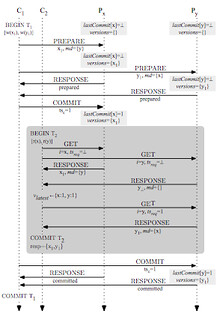The email sent will contain a link to this article, the article title, and an article excerpt (if available). For security reasons, your IP address will also be included in the sent email.

We are not yet at the End of History for database theory as Peter Bailis and the Database Group at UC Berkeley continue to prove with a great companion blog post to their new paper: Scalable Atomic Visibility with RAMP Transactions. I like the approach of pairing a blog post with a paper. A paper almost by definition is formal, but a blog post can help put a paper in context and give it some heart.
From the abstract:
Databases can provide scalability by partitioning data across several servers. However, multi-partition, multi-operation transactional access is often expensive, employing coordination-intensive locking, validation, or scheduling mechanisms. Accordingly, many real-world systems avoid mechanisms that provide useful semantics for multi-partition operations. This leads to incorrect behavior for a large class of applications including secondary indexing, foreign key enforcement, and materialized view maintenance. In this work, we identify a new isolation model—Read Atomic (RA) isolation—that matches the requirements of these use cases by ensuring atomic visibility: either all or none of each transaction’s updates are observed by other transactions. We present algorithms for Read Atomic Multi-Partition (RAMP) transactions that enforce atomic visibility while offering excellent scalability, guaranteed commit despite partial failures (via synchronization independence), and minimized communication between servers (via partition independence). These RAMP transactions correctly mediate atomic visibility of updates and provide readers with snapshot access to database state by using limited multi-versioning and by allowing clients to independently resolve non-atomic reads. We demonstrate that, in contrast with existing algorithms, RAMP transactions incur limited overhead—even under high contention—and scale linearly to 100 servers.
What is RAMP?














 Return to Article
Return to Article